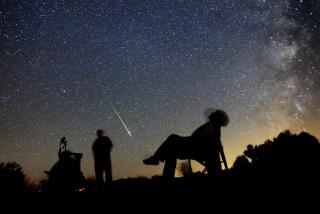Scientists Focus High-Tech Gear on Sprites
- Share via
FORT COLLINS, Colo. — When lightning flashes out of a thunderhead and crashes to earth, something else may be going on above the clouds: flickering red and blue bolts of light thrusting 60 miles into the ionosphere.
It’s a phenomenon scientists refer to as sprites. The dictionary defines a sprite as “an imaginary being or spirit.”
Since discovering sprites six years ago, scientists have been trying to find out what they are. They could be benign phenomena such as rainbows or halos, or they could be responsible for disrupting radio communications and contributing to the so-called greenhouse effect.
“It may turn out these [sprites] are an important part of the global electrical circuit,” said meteorologist Walter Lyons at his NASA-funded high-tech observation post on windy Yucca Ridge east of here.
But, he added, “I’m not volunteering to be the first person to fly through one.”
Scientists here are trying to capture the above-the-storm, millisecond light shows with low-light-sensitive video cameras. So far, they have learned that sprites come in several varieties.
Red sprites resemble auroras and can thrust 60 miles into the ionosphere in a split second and vanish. Brighter ionospheric flashes can precede a red sprite, lasting just a thousandth of a second.
And there is the “blue jet”--a narrow, blue shaft of light that thrusts upward from a thunderhead at about 60 miles a second. Some scientists think a blue jet might have destroyed a research balloon floating above a thunderstorm at 129,000 feet.
The high-altitude optical phenomena are triggered by lightning in the storm clouds, said Lyons, whose specialty has been lightning since he earned his doctorate in geophysical sciences 25 years ago at the University of Chicago.
“Just as static on your radio is produced by lightning, these are optically produced by lightning. . . . The key questions are, what is it and how does it work?” he said.
“The electrical aspect might interfere with communications and on-board computers of aircraft and spacecraft. What is its impact on radio transmissions? The real big question is, what impact do they have on the chemistry of the atmosphere?”
The study of sprites began July 7, 1989, when University of Minnesota professor Jack Winckler was testing a special low-light video camera to be sent up on a research rocket, Lyons said.
Winckler filmed a thunderstorm 155 miles from his laboratory, and on the videotape appeared what some describe as a shimmering jellyfish; others compare it to a flowerpot skyrocket trailing tendrils of light.
“He had made the first observation of one of these on video,” Lyons said. “He called me. From that point on, I became increasingly interested and wrote a proposal to NASA.”
Lyons set up shop on Yucca Ridge in July 1993 and got a $600,000 NASA grant that carries the project through April. Lyons said the National Aeronautics and Space Administration wants to know whether sprites present a threat to spacecraft on launch or reentry, or to the next generation of aircraft that will routinely travel at extremely high altitudes.
There are 18 other partners in the study at Lyons’ outpost, including Lawrence Livermore National Laboratory, Tohoku University of Japan, Massachusetts Institute of Technology, Lockheed Martin Corp., the universities of Minnesota and Alaska-Fairbanks, and the Air Force Academy.
Lyons said his project is the only one now attempting optical observation of sprites. He said scientists in several other states are trying to take radio measurements of sprites and are sending him data.
On moonless nights, Lyons and other scientists aim surveillance equipment at thunderstorms over Nebraska and Kansas 150 to 200 miles away, hoping to glimpse a sprite.
On Aug. 2, Lyons’ group pulled up stakes and headed for Kennedy Space Center in Florida to look at sprites over the launch pad.
Lyons said the scientists’ first job was to figure out what instruments to use. He compared the project to photographing the “Invisible Man” or “designing a cage to capture an animal you don’t know anything about. Is it the size of an elephant or is it a snake?”
The observation post has been using image-intensifying low-light video cameras, ultra-low-frequency radio receivers and a high-speed photometer brought by Japanese scientists that resembles a supersensitive light meter.
Now, newer, bigger, faster instruments are being brought in--a state-of-the-art computer-imaging system and a radar system.
“Lawrence Livermore Labs are bringing out an imaging system, really a computer display, that hopefully will run at 1,000 images per second,” Lyons said. “Our video cameras only catch 60 images a second. That’s too slow. We’re not missing, but we don’t see how it develops because everything is moving so fast.”
SRI International, the old Stanford Research Institute, plans to try bouncing radar off the sprites, he said. Aircraft have been employed for sprite observations in the past, he said, but the flights are expensive.
“If these do have a significant impact on the chemical processes in the stratosphere, we must understand them or we won’t understand the impact they will have on global change or the next generation of aircraft who will operate in the stratosphere,” Lyons said.






